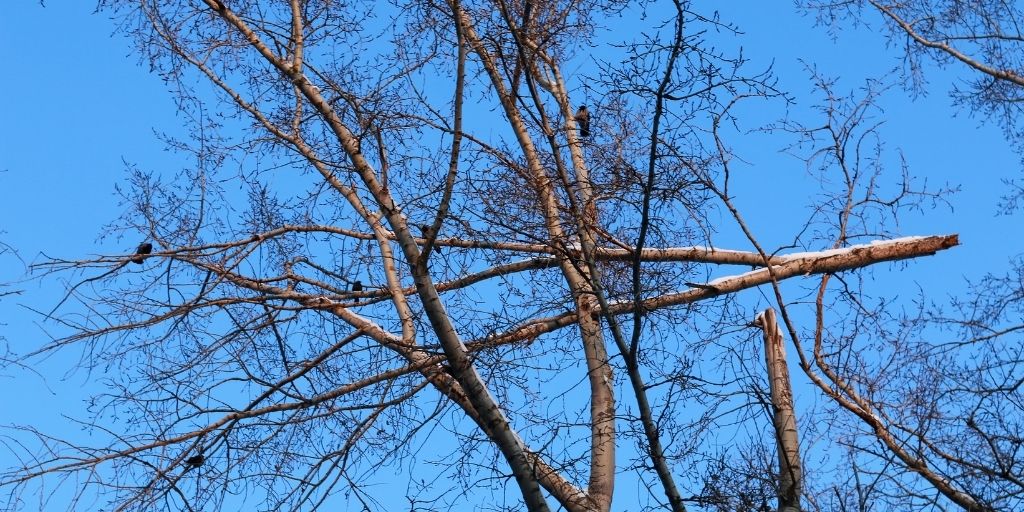How can you tell if your tree is dangerous? Are there signs that can indicate whether it poses a hazard to people and structures around it?
Although trees provide significant benefits to our environment and to us, they can become a liability when they pose a risk of damaging nearby structures or injuring people. There are certain problems or defects that make a tree more likely to be dangerous and it’s important to know how to identify those risks.
In this article, we cover:
- common structural and other defects affecting trees in urban and suburban environments,
- the problem areas to look for,
- how you can inspect a potentially dangerous tree, and
- how to evaluate the key defects that can make it a hazard to structures and people nearby.
What is a hazard tree?
In arboriculture, we refer to a dangerous tree as being a “hazard tree” when it:
- has a risk of failure,
- that failure will likely result in damage to property and/or injury to people, and
- the amount of expected damage and/or the level of risk exceeds the level that the property owner is willing to accept.
Although there is no such thing as a completely “safe” tree, a tree only becomes a hazard if it has the potential to hit a target (something or someone).
As a property owner, it’s your responsibility to ensure that the trees on your property are not hazardous.
Common Tree Defects
According to the International Society of Arboriculture, the following defects or signs of possible defects are commonly found in trees growing in urban and suburban areas.
- Regrowth from topping, line clearance, or other pruning
- Electrical line adjacent to the tree
- Broken or partially attached branches
- An open cavity in the trunk or branch
- Dead or dying branches
- Branches arising from a single point on the trunk
- Decay and rot present in old wounds
- A tree that has been struck by lightning
- A recent change in grade or soil level, or other construction damage
- A tree leaning near a target
- Forked trunk with branches and stems of equal size (co-dominant stems)
- Trees growing in shallow soil, wet areas, or areas without enough soil volume to accommodate root growth
How to Inspect Your Trees
Ideally, you should inspect all trees on your property every year. Although these inspections can be done at any time of year, they are best done in late fall or winter when there are no leaves on the trees or immediately after trees leaf out in spring. It’s also a good idea to routinely inspect trees after a severe storm. A thorough inspection can help you catch any potential problems before the tree becomes unsafe or the defect can no longer be corrected.
When you inspect your trees, do so carefully and systematically. Thoroughly look at all parts of the tree from all sides. This includes:
- any roots you can see above ground,
- the root or trunk flare (where the trunk enters the ground),
- the main trunk and all bark on the trunk,
- all of the branches, and
- where branches attach to the main trunk.
It’s easier to inspect areas near ground level but you can also view the tree canopy using binoculars.
What to Look For
The reality is that very few trees fail or fall over without warning. There are usually signs and symptoms that indicate a tree has the potential to be a hazard.
Below, you’ll find a list of things to look for to evaluate the safety of your own trees. However, we strongly recommend having a thorough evaluation done by an ISA certified arborist who can evaluate the severity of any defects and the risk of failure.
Poor Tree Shape
Most trees don’t look like the lollipops we drew in kindergarten; they often have an irregularly-shaped canopy, sometimes with gaps between branches or even a few bare spots. Depending on the tree, that may be perfectly normal. However, there are some irregularities that indicate a tree may be structurally defective and at risk of failure. Often, poor tree form is caused by storm damage, drought or other poor growing conditions, improper pruning, tree topping, or other types of damage.
Look for these signs that a tree’s shape may be a problem:
- Unbalanced or very lopsided crown
- Leaning tree
- A large branch that’s out of proportion with the rest of the canopy
- Large, heavy branch extending over a structure, roadway, walkway, patio, etc.
>> How to prevent leaning tree problems
Deadwood
Many trees will have some dead twigs and even dead branches in the canopy. While a few dead twigs aren’t necessarily dangerous, larger dead branches, particularly broken branches that are hanging up in the tree, can be especially dangerous. Deadwood is often brittle and prone to breakage; dead branches can break and fall at any time, damaging or injuring anything beneath them (there’s a reason why dead hanging branches are sometimes called “widow-makers”).
Look for these signs that deadwood may be a problem:
- A broken branch is hanging in a tree
- The tree itself is dead
- A large branch is dead although it’s still be attached to the tree. Typically, a branch that’s larger than 4 inches in diameter is large enough to cause serious injury. However, even smaller branches can cause injury if they fall from high in the tree.
Cracks in Trunk or Branches
Sometimes, cracks are obvious. Other times you need to look more closely to notice the deep split in the tree bark that indicates a crack. Dangerous cracks are ones that extend through the bark into the living wood of a tree. Often, a deep crack in the tree bark indicates that the tree is already failing.
Look for these signs of cracks that indicate a problem:
- A crack extends deeply into, or completely through, the tree trunk or branch
- Two or more cracks occur in the same general area of the stem
- A large crack appears after a tree is struck by lightning
- A crack is in contact with another defect
- A branch of sufficient size to cause injury is cracked (typically larger than 4 inches in diameter)
Weak Branch Attachments
A weak attachment, also called a weak branch union, refers to a branch that is not strongly attached to the tree. This often happens when two or more branches grow so closely together that bark grows between the branches and inside the attachment point or union. This bark, called included bark, is much weaker than normal wood and makes the attachment point unstable.
Trees with branches that tend to grow upright, such as Elm, Maple, and Bradford pear, often have weakly attached branches. Trees with codominant stems, or multiple main trunks growing from the same point, are also prone to failure due to included bark where the two trunks meet. Finally, watersprouts that quickly grow back after a tree has been topped are also weakly attached and prone to breakage.
Look for these signs of weakly attached branches that could become a hazard:
- Two or more main trunks are growing close together from the same point
- A large branch is growing from the trunk at a very narrow angle (called a V crotch)
- A recently topped tree is putting out a lot of new growth at the ends of the cut branches
- You notice a weak branch union very close to a crack, area of decay, canker, or another defect
Decay
The presence of decay alone does not necessarily mean that the tree is dangerous or at risk of failure. However, signs of advanced decay such as conks, mushrooms, crumbling wood, and cavities within the tree, are more likely to be serious.
Decay usually starts inside the tree where it’s not visible. Over time, it forms a cavity or hollow area that may extend to the exterior of the tree. If the tree is still growing, new wood is continuously added to the outside of the tree as it grows, giving it a strong outer shell. Sometimes, a hollow tree can still be structurally sound and does not need to be removed.
Because it’s not always easy to tell whether a decaying tree is safe or not, we recommend that safety evaluations be done by a certified arborist with the experience and equipment to assess the tree’s condition.
Look for these signs that decay is making your tree unsafe:
- A large branch is clearly decayed
- There are large conks, mushrooms, or areas of soft rot clearly visible in several locations on the tree
- The thickness of sound wood is less than one inch for every 6 inches of diameter at any point on the tree trunk
- The tree is showing signs of advanced decay and also has other defects
Root Problems
We don’t usually think about what’s going on underground, but a tree’s root system is critical to the health and safety of the tree itself. Trees that unexpectedly fall over often have serious root problems that led directly to the tree’s failure.
While we cannot usually assess the health of a tree’s root system directly, there are signs to look for above ground that indicate there are root problems going on. For example, if you notice dieback in the tree canopy, yellowing or smaller than normal leaves, or a general failure to thrive, it’s likely that the tree has root damage or decay.
Root problems are often caused by things that could be easily avoided with a little planning. Nearby construction or landscaping, soil compaction such as from traffic or heavy equipment, raising or lowering the depth of soil over the root zone, poor drainage, or insufficient space for root growth can all compromise the root system of your tree.
Look for these signs of root decay or other defects that could pose a hazard:
- The tree is starting to lean or is leaning more than before
- Soil is heaving on one side of the tree truck
- More than half of the tree’s roots have been cut or damaged
- The trunk flare where the trunk transitions into roots is buried well beneath the soil level
- There are signs of advanced decay at the base of the tree or on visible roots
PRO TIP: A tree with defects is not hazardous unless some portion of it is within striking distance of a target.
Need a Hand?
With proper care and regular maintenance, many tree species can easily outlive us – but they don’t live forever. And, sometimes, unforeseen events happen. From insect damage (such as from emerald ash borer) to drought or heat stress and winter ice storms, there are many reasons why a tree can become dangerous.
If you suspect you have a hazard tree on your property, or you’re concerned that a declining tree may become dangerous, the first step is to have a thorough and professional inspection by an ISA Certified Arborist. An arborist can evaluate the condition of the tree and let you know the degree of risk it poses. Together, you can then decide whether to remove the tree, do some sort of preventive maintenance (such as pruning or cabling), or leave it alone.








